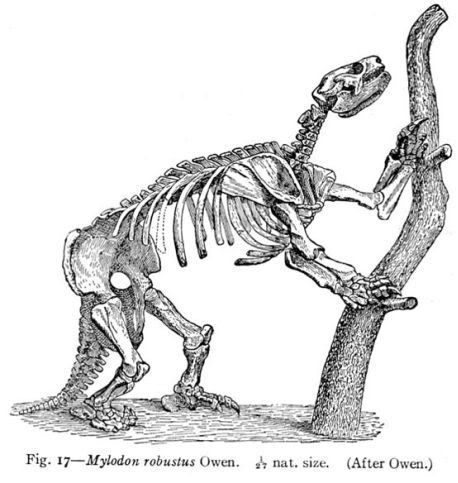Post by bluefedish on Jan 22, 2008 2:38:30 GMT -5
A genus of giant ground sloth that lived in the Patagonia area of South America until roughly 10,000 years ago.
Mylodon weighed about 200 kilograms and stood up to 3 meters tall when raised up on its hind legs. Preserved dung has shown it was a herbivore. It had a very thick hid and grew small round pebble-like bones within its skin for added armor. Because of this armor and its own long and sharp claws, it's unlikely the mylodon had any natural enemies; even in the case of man, the skin would also have been very difficult to pierce with stone tipped arrows.
May samples of preserved hide and dung have been discovered, they are in such a good state of conservation that the people who first discovered them believed they belonged to a living animal instead of an extinct species. During the 'The Voyage of the Beagle' bones with skin still attached were found by Charles Darwin on the beach of Bahia Blance 1834.
Mylodon's closest relatives include the giant ground sloths of the genera Glossotherium and Paramylodon (the latter genus has often been confused with the former). The elephant-sized Megatherium is often said to be related, too, but belongs to a separate family.
Recent Survival Claims and Cryptozoology
It has been claimed that small populations of Mylodons survived long past 8,000 years BC, and possibly as late as the 1500s. It's claimed to be documented in a drawing on the Piri Reis map of 1513.
A picture of Mylodon, or something resembling it, was drawn in 'The Illustrated Record of Strange Countires' written in China in 1430. Gavin Menzies speculates that some of the creatures were brought back to China on the treasure Fleets of Zheng He as a gift to the Emperor. However, considering the lack of any compelling evidence whatsoever for a Chinese visit (i.e., bones of the beast, journal records detailing it being brought on board) to Patagonia during this period, these claims should be treated with the utmost skepticism.
The discovery of fresh looking samples of skin and dung sparked a small wave of expeditions during the early 20th century to search for a living example of the animal (the samples have since been found to be around 10,000 years old). The remains look fresh because of the extreme cold and stable conditions in the caves in which they were found. These expeditions found little or nothing of scientific value. All expeditions were hampered by the extreme weather, nearly impenetrable forest and extremely rugged terrain. If the species does survive, it does so in one of the most inaccessible regions of the world.

Selected Source:
en.wikipedia.org/wiki/Mylodon
Mylodon weighed about 200 kilograms and stood up to 3 meters tall when raised up on its hind legs. Preserved dung has shown it was a herbivore. It had a very thick hid and grew small round pebble-like bones within its skin for added armor. Because of this armor and its own long and sharp claws, it's unlikely the mylodon had any natural enemies; even in the case of man, the skin would also have been very difficult to pierce with stone tipped arrows.
May samples of preserved hide and dung have been discovered, they are in such a good state of conservation that the people who first discovered them believed they belonged to a living animal instead of an extinct species. During the 'The Voyage of the Beagle' bones with skin still attached were found by Charles Darwin on the beach of Bahia Blance 1834.
Mylodon's closest relatives include the giant ground sloths of the genera Glossotherium and Paramylodon (the latter genus has often been confused with the former). The elephant-sized Megatherium is often said to be related, too, but belongs to a separate family.
Recent Survival Claims and Cryptozoology
It has been claimed that small populations of Mylodons survived long past 8,000 years BC, and possibly as late as the 1500s. It's claimed to be documented in a drawing on the Piri Reis map of 1513.
A picture of Mylodon, or something resembling it, was drawn in 'The Illustrated Record of Strange Countires' written in China in 1430. Gavin Menzies speculates that some of the creatures were brought back to China on the treasure Fleets of Zheng He as a gift to the Emperor. However, considering the lack of any compelling evidence whatsoever for a Chinese visit (i.e., bones of the beast, journal records detailing it being brought on board) to Patagonia during this period, these claims should be treated with the utmost skepticism.
The discovery of fresh looking samples of skin and dung sparked a small wave of expeditions during the early 20th century to search for a living example of the animal (the samples have since been found to be around 10,000 years old). The remains look fresh because of the extreme cold and stable conditions in the caves in which they were found. These expeditions found little or nothing of scientific value. All expeditions were hampered by the extreme weather, nearly impenetrable forest and extremely rugged terrain. If the species does survive, it does so in one of the most inaccessible regions of the world.

Selected Source:
en.wikipedia.org/wiki/Mylodon



